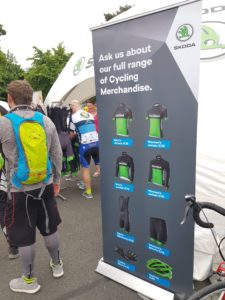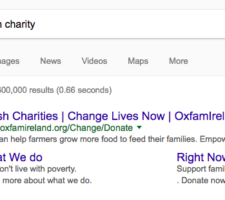I nearly cried when I finished a big charity cycle recently. It wasn’t because I was exhausted after cycling for over seven hours. It was simply because there were people from the charities involved handing out medals at the finish line. It was only then that I realised how much this fundraising for charity cycling mattered to them when for me it was just another day in the saddle.

Opportunities for fundraising for charity cycling are often missed at the finish line where commerical brands are much more prominent.
As I sat down with a strong cup of tea to recover I reflected on this realisation that the whole event was actually something that the charities that were benefiting from my registration fee saw as a really important fundraiser. But as I looked around I could see that it was the big commercial brands that were involved as sponsors that had activated their sponsorship best before, during and after the bike ride. It was clear that the non-profits involved had actually missed a lot of opportunities to raise more money. I was surrounded by stands and signage for all the brands that had sponsored the event. There was little to no evidence of the many charities that the whole event had been a fundraiser for apart from a few well-meaning volunteers wearing t-shirts and handing out the medals.
Coming at this from my background in marketing, fundraising and award-winning CSR campaigns it struck me that many opportunities are being missed and that’s making fundraising for charity cycling more challenging than it should be. So here are my top three ideas for charity bike ride fundraisers because far from losing popularity, they’re going from strength to strength for everything from fundraising for schools to raising awareness for international nonprofits. (You might also find my Cycle Clothing Ireland complete guide useful if you’re going to be going on a charity cycle yourself and wondering what the best cycling gear to wear is.)
1. BE MORE TRANSPARENT WHEN FUNDRAISING FOR CHARITY CYCLING
Unfortunately, people are losing trust in non-profit organisations all over the world. It’s not unusual for nonprofits to hit the news headlines for all the wrong reasons – from financial controversies in Ireland to misconduct issues internationally.
That means financial transparency is key to fundraising at charity cycles because it builds trust. It needs to part of the planning for bike ride fundraisers from the beginning because it drives event registrations and motivates people to pay a higher fee knowing that a proportion of the money they spend is going to something that’s important. But people do need to know where their money is going. They no longer accept it’s simply “going to a good cause.” Instead, they actively ask questions about where exactly the money is going and how it will be spent. And if you don’t tell them where the money is going they’ll start a conversation online to try to find out why – which can unfortunately very quickly lead to all sorts of unfounded rumour and speculation.
The registration fees for the charity cycles vary widely. And prices seem to be on the up. People are openly questioning where all the money goes. All they see that they’re getting in return is a couple of bananas and far too many Nature Valley bars.
(Side note: The makers of Nature Valley bars should actually pay charity bike ride and sportive organisers not to give people their bars because everyone gets sick of the sight and taste of them! This counter-intuitive idea of paying people not to use your products can be an important part of marketing strategy as Jonah Berger has written about in his fascinating book Invisible Influence).

Tour de Foothills fundraising results
So it’s important to be proactive and tell people upfront what percentage of the registration fee is going to actually reach the charity – and what the charity will actually use it for. The Tour de Foothills sportive is an event I love doing every year – not just because it’s often one of the first sportives of the season in Ireland, but because they are very clear about the specific way they’re going to spend the money.
But not all charity bike rides are as clear about where the money goes. This lack of transparency is having a knock-on effect on participation numbers in charity cycles, and also risks tarnishing the brands of both the events and the charities supposedly benefiting from them.
An example of where things can go wrong is unfortunately the annual Ring of Kerry charity cycle. A quick scroll through the Ring of Kerry charity cycle thread on Boards.ie will leave you in no doubt as to negative sentiment surrounding the high registration fee charged for that event (a massive €103.50 including booking fee in 2018) and the questions being asked openly about where all the money goes. That could be one factor in the massive drop in participation numbers which fell by 3,000 people in just one year (down from 10,000 in 2017 to reportedly 7,000 in 2018) – although in fairness other factors such as bad weather and overcrowding the previous year could have dampened repeat sign-ups too.
This financial transparency is sometimes seen as a tick-the-box thing that nonprofits now have to do. But it shouldn’t be seen as a burden for charities because it is actually a great opportunity to raise awareness and tell the story about the purpose of the charity’s work and make a case for bigger donations. Brands are all that purpose these days and non-profits have a huge opportunity to actually tell much more authentic stories about their purpose and the impact of their work.
2. FUNDRAISE FOR CHARITY CYCLING WITH MERCHANDISE
People will donate a certain amount through registration beforehand and might even drop some loose change into buckets on the day. But there is a huge opportunity to raise even more money fundraising for charity cycling through merchandise sales. From wristbands to jerseys, cyclists love their gear and will pay almost any money for a cool bit of kit. Many cyclists also want to feel part of a tribe. And what better tribe to belong to than one doing something altruistic to benefit a charity.

Skoda-branded cycling gear for sale at the finish line.
Skoda have very cleverly tapped into this. As a spin-off from their Tour de France sponsorship, they’ve designed an impressive range of kit that looks good even though its design entirely on the Skoda brand. They do subsidise the kit sales, but it still costs a significant amount of money to buy from them. And they activate the sponsorship very cleverly. In the run up to the Ring of Kerry cycle this year, they pushed it on social media as a must buy piece of kit. And the only way to buy it was by visiting a Skoda dealership. During the event, the people who’s already succumbed effectively cycled around advertising it to their fellow cyclists. So to close the loop, Skoda had a stand what you could buy it at the end of the charity cycle too.
Charities are missing a trick here by not upselling branded clothing. As Mark Loughran of the Bray Wheelers Cycling Club revealed in an Irish Times piece by Fiona Alston a while back, us cyclists (surprisingly perhaps) believe we actually look good in lycra. So we can’t get enough of the stuff. David McWilliams might have his own views on us Mamils and Willows, but we’ll spend almost any money on tight kit.
Lance Armstrong had cyclists penchant for accessories well figured out with his yellow Livestrong wristbands. Not that any of us should use him as a role model anymore. But surely on arrival at a sportive, charities should be immediately up selling branded wristbands. They only cost pennies to organise, but can be sold for many multiples of that.
I’ve seen the Irish Cancer Society distribute luminous branded vests which go some way towards creating a sense of a group working together and raise the profile of the charity among other people there.

Stylish branded jerseys raised the profile of this UK-based nonprofit.
But the real opportunity is in getting people to buy charity branded clothing like the ones shown here by UK-based charity MyelomaUK. It’s relatively straightforward to order custom cycling jerseys and even design impressive ones almost automagically online – but pricing is expensive for small quantities.
As the quantities go up though, the pricing can drop dramatically so there is plenty of opportunity to make a margin on each sale. Stock management of clothing types and sizes could become an issue, but for larger charities present at several charity bike rides a year the risk is very manageable and the opportunity to fundraise more is very real.
Not only does the upselling of branded merchandise offer an extra source of income and way to monetize things, it significantly raises the profile of the charity – and it helps create a sense of community by enabling individual charity supporters to recognise each other easily and cycle as an ad hoc group if they want to.
3. GROW YOUR COMMUNITY WHILE FUNDRAISING AT CHARITY BIKE RIDES
Everyone’s a bit scared of e-mail mailing lists now that GDPR has kicked in. But as long as people opt-in in a trackable way (and can easily opt-out at any time), then email lists are still a really powerful way of growing a charity’s community for the long-term.
Many charity bike ride organisers already communicate with people about event logistics before and after events. Then that’s usually it. Radio silence after that. That’s a huge missed opportunity. Not only could charities tell more of their story in the initial e-mails, they could also encourage people to opt-in to e-mails about their work on an ongoing basis after their event. That way they would keep people engaged, not only driving registrations with advance notice of “charity cycles near me” but also potentially creating new advocates and donors for the long-term as they tell their story in each mail out.
There’s lots of talk in marketing these days about “customer lifetime value” and charities should also be thinking this way. There’s a lot to be said for “cyclist lifetime value” when it comes to fundraising for charity cycling because they are a proven fundraising model. By putting these three ideas into practice – from greater transparency, to upselling merchandise to growth hacking a community – non-profits can build on their existing work to bring their fundraising to the next level. And that will help them do more great work and improve the lives of the people they’re there to help.
If you’ve ideas of your own that could help charities fundraise more from charity cycles or want to share your experience of what does and doesn’t work, please do let me know in the comments below or ping me a message.
Updated 2/8/2018: Thanks to Naas Cycling Club, organisers of the Tour de Foothills, for sending on sample visuals of how they communicate their fundraising results. I’ve included one in the post now.



